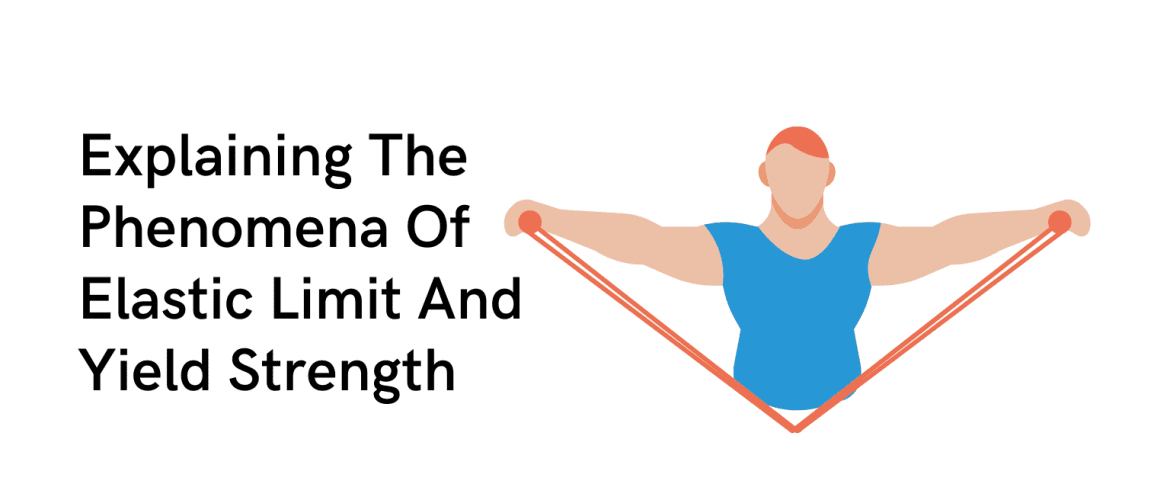Imagine a rubber band. You can stretch it, twist it, and turn it into all sorts of shapes.
But have you ever wondered why it doesn’t just keep stretching until it snaps? Or why a piece of metal can be bent and reshaped, but only to a point?
The answers to these questions lie in the fascinating world of material science, and two key concepts within it: the elastic limit and yield strength.
Elastic limit and yield strength are like the safety barriers of materials.
They determine how much a material can take before it permanently changes its shape or, in some cases, breaks.
Understanding these phenomena is not only a fundamental aspect of science and engineering but also an essential piece of everyday life.
In this journey, we will explore what these concepts mean, why they matter, and how they impact the things we use and rely on daily.
So, whether you’re intrigued by the strength of a bridge, the flexibility of a phone case, or simply the science behind your springy hair ties, let’s delve into the world of elastic limit and yield strength to uncover the science behind these fascinating material behaviors.
Elastic Limit
The elastic limit, also known as the proportional limit, is a fundamental concept in the physics of materials, especially in the study of elasticity.
It represents the maximum stress a material can withstand without undergoing permanent deformation (i.e., without changing its shape or size) when an external force is applied.
Beyond the elastic limit, the material will experience permanent deformation, which means it won’t return to its original shape when the stress is removed.
This phenomenon is described by Hooke’s Law.
Hooke’s Law states that within the elastic limit, the stress (σ) applied to a material is directly proportional to the strain (ε) it undergoes. Mathematically, this relationship is expressed as:
σ = E * ε
Where
- σ is the stress applied to the material (measured in Pascals, Pa, or N/m²).
- E is Young’s Modulus, also known as the modulus of elasticity (measured in Pascals, Pa).
- ε is the strain, which is a dimensionless quantity representing the fractional change in length or shape of the material.
In simple terms, within the elastic limit, the material behaves like a spring, returning to its original shape and size when the external force is removed.
This linear relationship between stress and strain is a characteristic of elastic materials.
Yield Strength
The yield strength is another important material property, representing the stress at which a material begins to undergo plastic deformation (permanent deformation) without a significant increase in strain.
In other words, it’s the point at which a material transitions from elastic behavior to plastic behavior.
Beyond the yield strength, the material will not return to its original shape even if the applied stress is removed.
Yield strength is typically determined through mechanical testing, such as a tensile test, in which a material specimen is subjected to increasing levels of stress until it exhibits a noticeable deviation from linear elastic behavior.
This deviation is an indication that plastic deformation has begun.
Yield strength is a critical parameter for engineers and material scientists because it defines the upper limit of the material’s safe working range.
Materials with higher yield strengths are generally preferred for applications where strength and durability are essential, such as in the construction of bridges, buildings, and aerospace components.
Strain Energy In Deformed Materials
Strain energy, also known as elastic potential energy, is a fundamental concept in the study of deformed materials, especially in the field of solid mechanics and materials science.
It refers to the energy stored within a material when it undergoes deformation or strain.
This energy is a result of the work done by external forces to change the shape or size of the material.
Strain energy plays a crucial role in understanding material behavior, as well as in various engineering applications.
Here’s a more detailed explanation of strain energy in deformed materials:
Deformation and Strain
When an external force is applied to a material, it causes the material to deform, either by stretching, compressing, twisting, or shearing.
This deformation results in changes in the material’s shape and size and is quantified by a property known as strain.
Strain is a dimensionless quantity that describes how much a material has deformed relative to its original state.
Work Done and Strain Energy
As the external force causes the material to deform, work is done on the material.
This work done is equal to the force applied multiplied by the displacement over which the force acts.
The work done by the external forces is stored as strain energy within the material.
This energy is stored in the form of potential energy within the atomic or molecular structure of the material.
Hooke’s Law
In many cases, within the elastic limit (where the material behaves elastically and returns to its original shape upon the removal of the force), the relationship between stress (σ) and strain (ε) can be described by Hooke’s Law.
Hooke’s Law allows for a linear relationship between stress and strain, and the area under the stress-strain curve represents the strain energy stored in the material during deformation.
Release of Strain Energy
When the external forces are removed, the strain energy stored in the material is released.
If the material has undergone elastic deformation and has not exceeded its elastic limit, it will return to its original shape, and the strain energy will be completely recovered.
However, if the material has undergone plastic deformation (beyond its elastic limit), some of the strain energy will be dissipated as heat due to irreversible changes in the material’s structure.
In engineering and design, understanding strain energy is crucial for predicting material behavior, designing structures, and ensuring that components can withstand loads without exceeding their elastic limits.
It’s also essential for calculating safety factors and optimizing designs to minimize the potential for permanent deformation and failure in materials and structures.
In Summary
In summary, the elastic limit represents the maximum stress a material can withstand without undergoing permanent deformation, described by Hooke’s Law within this limit.
The yield strength is the stress at which a material begins to exhibit plastic deformation, marking the transition from elastic to plastic behavior.
Both of these properties are essential for understanding and designing materials for various applications.
Strain energy in deformed materials is the potential energy stored within a material when it undergoes deformation or strain due to external forces.
This energy is a result of the work done to change the material’s shape or size.
Strain energy is a fundamental concept in solid mechanics and materials science, and it plays a crucial role in understanding material behavior, designing structures, and predicting how materials respond to loads.
It is governed by Hooke’s Law within the elastic limit and is released when the external forces are removed, allowing materials to return to their original shape in elastic deformation or dissipating as heat in plastic deformation.




Leave A Comment